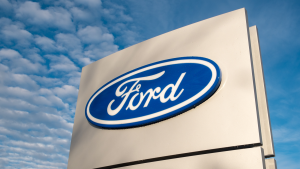In recent times, the buzzing topic in the realm of auto stocks has been the strike initiated by the United Auto Workers Union. However, peering beyond this immediate hurdle, long-term investors should be more interested in the prospects of autonomous driving and the proliferation of electric vehicles (EVs). These transformative trends, vibrant in potential, should be the guiding stars. Hence, the ideal auto stocks to buy are those that are effectively poised to embrace future-forward shifts while trading at attractive prices. With a whopping 79.4 million units in global auto sales in the backdrop, there’s no denying the importance of auto stocks in curating a robust investment portfolio. As we dive deeper, here are seven auto stocks to buy that stand out from the crowd.
Auto Stocks To Buy: Toyota (TM)

Toyota (NYSE:TM) is not just a legacy brand with a storied past in the automotive realm, but it’s now forging ahead toward a charged future. The company’s recent announcement of a comprehensive EV strategy marks a pivotal turn. Previously anchored in gas-electric hybrid technology under the visionary leadership of CEO Koji Sato, the automaker is looking to make waves by targeting an impressive annual rollout of 3.5 million battery-operated vehicles by 2030. Its impressive 28% climb this year underscores its optimism.
As we shift gears toward 2025, the industry is abuzz with Toyota’s forthcoming unveiling of its revolutionary solid-state battery, positioning it as a luminary in the affordable EV sphere. Moreover, with global EV sales projections soaring and anticipated to grow by 137% by 2024, Toyota is clearly in the driver’s seat. Consequently, investors and analysts alike are tipping their hats to TM’s strategic shift towards a fully electric lineup.
Magna (MGA)

Magna (NYSE:MGA) is a fascinating player in the automotive sphere, mainly known for crafting the Fisker Ocean SUV. This Canadian OEM giant isn’t just a major player in the EV domain; it also boasts a robust position in the advanced driver assistance system (ADAS) arena. With a diversified footprint that surpasses many of its pure-play rivals in the autonomous driving sector, Magna offers investors an enticing blend of safety and growth potential, making it an attractive long-term bet.
Furthermore, its mid-point guidance for 2025 revenue has been revised upwards to $48 billion from the earlier $46 billion. This reflects a new projected range of $46.7 billion to $49.2 billion, up from the previous forecast of $44.7 billion to $47.2 billion. This revision, mainly attributable to the company’s Power & Vision unit’s stellar performance, points to a bright future ahead. This unit, responsible for essentials including powertrain systems and electronic systems, positions Magna at the heart of the global vehicle electrification wave.
Adding to its roster of achievements, Magna recently sealed a deal to furnish its eDrive system, termed eDS Mid, to a prominent European luxury car manufacturer. This partnership signals a vote of confidence in Magna’s tech, hinting at the potential for similar deals with other industry heavyweights.
Ford (F)

Ford (NYSE:F), which has established itself as an esteemed name in the automotive space, is effectively navigating the road ahead with its Ford+ plan, aiming to cement its long-term positioning. A prime example of this strategy is Ford Pro, the company’s commercial arm, playing a critical role in driving both growth and profitability. Moreover, the appeal of Ford Pro to commercial customers produces 22% revenue growth; EBIT more than doubled to $2.4 billion.
Furthermore, the company business segment’s prowess is palpable, boasting a dominant 40% market share in the US commercial truck and van sector. Additionally, in the burgeoning EV space, Ford’s approach has been nothing short of visionary. Launching distinctive EV models such as the Lightning, Mach-E, and E-Transit, the company has not only diversified its portfolio but also captivated new clientele. Also, in the second quarter, its quarterly sales of $42.4 billion marked an 11.9% year-over-year (YOY) growth, surpassing analysts’ predictions. Meanwhile, net income totaled $1.9 billion YOY versus the $3.2 billion consensus. Such a robust charging framework underscores Ford’s commitment to fostering cost-effective and efficient EV charging solutions.
ChargePoint (CHPT)

ChargePoint (NYSE:CHPT), the ever-expanding charging network, continues to showcase its might in the EV charging realm, a testament to its stellar position in the sector. Posting impressive sales of $150.5 million for the second quarter, reflecting a 39% YOY growth, the numbers offer an encouraging view of the firm’s performance.
Perhaps the best element of ChargePoint’s business model is its charging system sales, and recurring software subscriptions paint a lucrative picture. More charging stations lead to higher subscription revenue, and with ChargePoint steering the ship with more than 200,000 charging ports, its financial trajectory looks promising.
Furthermore, it’s crucial to remember that CHPT’s recent amplified losses, clocking in at $124 million, suggest its transient nature. With anticipated sales ranging between $150 million to $165 million in the upcoming quarter, coupled with Tipranks analysts’ prediction of a whopping 121% stock surge from its existing levels, there are plenty of reasons to add CHPT to your list of auto stocks to buy now.
BYD Co. (BYDDF)

Warren Buffet’s esteemed pick in the EV domain, BYD Co. (OTCMKTS:BYDDF) is more than just an underdog; it’s a racing titan in the EV circuit. In addition to its incredible EV deliveries, it also stands tall as the second-largest battery manufacturer globally. Moreover, it delivered a 204.7% profit surge and 73% YOY growth in the first half, becoming a gold standard in its niche. Additionally, last month, the firm’s August delivery figures revealed a whopping 274,386 deliveries, reflecting a 57% YOY bump.
Globally oriented, BYD’s footprint expands further than just its domestic market. With its imminent production kickoff in Thailand by 2024 and ventures into Japan, France, and Australia, it’s evident that the company is eyeing worldwide dominance. The recent acquisition of U.S. firm Jabil Inc.’s mobility wing strategically bolsters its EV component capacity. It’s no wonder that trusted analyst firms like Goldman Sachs and Bernstein also echo this sentiment with their bullish outlook.
General Motors (GM)

General Motors (NYSE:GM) stands as a beacon of automotive excellence with its celebrated brands. Once a coveted jewel in Warren Buffett’s portfolio, GM continues to show resilience amidst market fluctuations. A testament to its enduring strength is the impressive net income of $2.57 billion in the last quarter, a notable jump from the $1.69 billion from the previous year. Even more promising, analysts project a rise in GM’s earnings per share to $7.71 this year, up from $7.59 in 2022.
Moreover, GM Financial reported a net income of $571 million in the second quarter, emphasizing its financial robustness. GM’s commitment to vehicle financing has garnered a substantial $13.7 billion in retail loans and leases, showcasing its continued relevance and dynamic market presence. GM’s resilience and potential growth make it a brand to watch.
Honda Motor (HMC)

Honda Motor (NYSE:HMC) is the second-largest Japanese automaker, with a market cap north of $51 billion. Branching out beyond vehicles, this dynamic powerhouse crafts everything from motorcycles and ATVs to aircraft. In fact, the recent numbers narrate a triumphant tale, with vehicle sales jumping to 901,000 in the latest quarter, a sizable bump from its prior-year showing of 815,000. Additionally, the company’s motorcycle sales revved up worldwide, tallying close to 4.5 million, a spike from the 4.2 million sold a year earlier.
Moreover, showing confidence in its trajectory, Honda is giving back to its investors. In 2023, the firm announced a buyback of $1.19 billion in shares, with plans to repurchase an additional $1.4 billion in 2024. Not to mention, shareholders also enjoy a generous 2.6% dividend yield. Furthermore, as my fellow InvestorPlace colleague Thomas Niel discussed, given that Honda’s U.S. operations are non-union, the ongoing UAW strike could potentially tip the scales in their favor. If their unionized rivals grapple with growing wage demands, Honda’s more competitive pricing could shine brighter in the U.S. market. Furthermore, as competitors potentially throttle back on electrification due to rising labor costs, Honda’s commitment to electric ventures could rev up its position.
On the date of publication, Muslim Farooque did not have (either directly or indirectly) any positions in the securities mentioned in this article. The opinions expressed in this article are those of the writer, subject to the InvestorPlace.com Publishing Guidelines.
